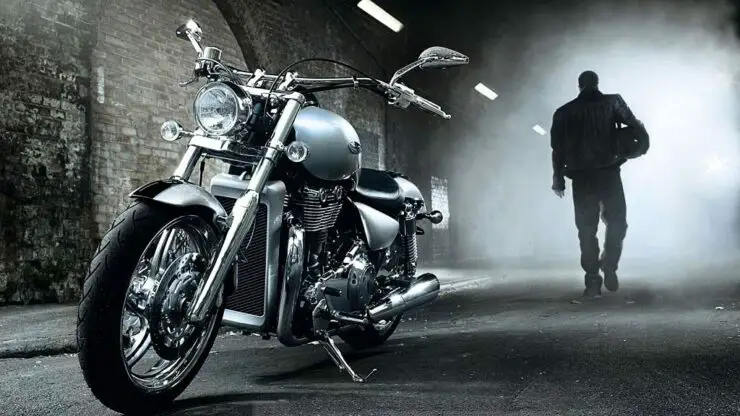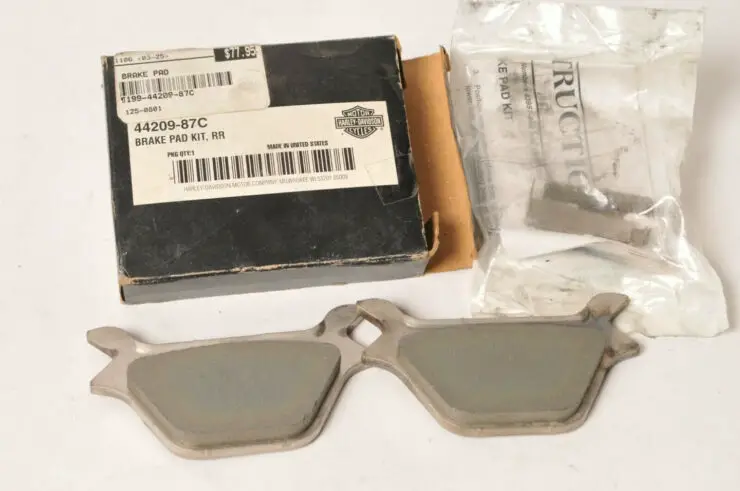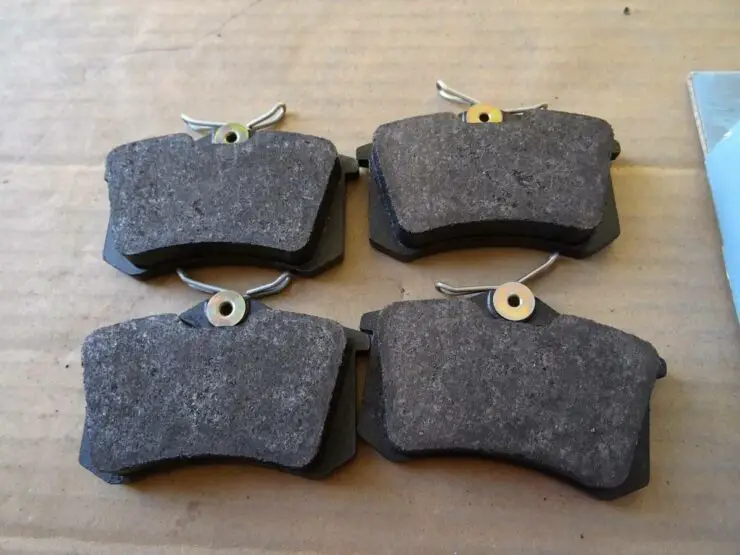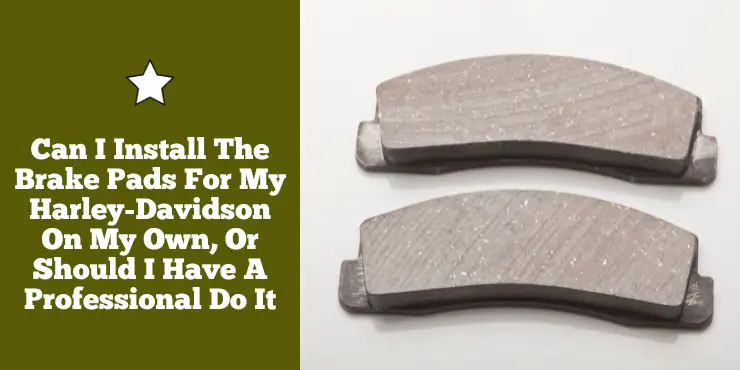Are you a Harley-Davidson enthusiast who loves taking care of your own maintenance? Or perhaps you’re someone who’s always up for a DIY challenge? Either way, when it comes to installing brake pads for your beloved motorcycle, you might find yourself wondering whether you should tackle the task yourself or leave it to a professional.
You can install brake pads yourself with basic tools and instructions, but if unsure, consult a professional to ensure correct installation and safety.
In this article, we’ll explore the considerations you should keep in mind when deciding whether to install brake pads for your Harley-Davidson on your own or seek the expertise of a trained mechanic. So, hang tight and get ready to delve into the world of brake pad installation – because by the end, you’ll have a clearer idea of which option suits you best.
Different components of brake pads in Harley-Davidson bikes
Brake pads are a vital component in any bike’s braking system. In Harley-Davidson bikes, they play an even more significant role. Harley-Davidson motorcycles are known for their power and performance. Maintaining an effective braking system will be important for rider safety.
>>> Click here to read our review of the Best Break Pads For Harley-Davidson <<<
Brake pads are friction materials that are used in disc brake systems for creating the needed friction for slowing down and stopping the bike. They are a critical part of the braking system as they come in direct contact with the brake rotor, which is a circular disc attached to the wheel. When the rider applies the brake lever, hydraulic pressure will be exerted on the brake pads, causing them to press against the rotor. This friction between the brake pads and the rotor is what brings the bike to a halt.
Here are the different components of brake pads in a Harley-Davidson bike –
#1. Friction material
The most important component of a brake pad is the friction material. Harley-Davidson makes use of a high-quality, heat-resistant friction material that can withstand the heat generated during braking. This material is typically made using a mixture of organic compounds, metallic elements, and ceramics. The specific composition can vary depending on the model and intended use of the bike.
#2. Backing plate
The backing plate is the metal component to which the friction material gets attached. It serves as the structural support for the pad and helps dissipate heat. In Harley-Davidson brake pads, the baking plate is often made from steel, providing the necessary strength and durability.
#3. Shims
Shims are thin, flat pieces of metal or composite material that are placed between the friction material and the backing plate. They serve multiple functions, including reducing vibration, noise, and harshness (NVH) during braking. Shims also help in dispersing heat and protect the brake caliper from excessive heat transfer.
#4. Wear indicator
Many Harley-Davidson brake pads come equipped with wear indicators. These are small metal tabs protruding from the surface of the pad. As the brake pads wear down, these tabs come in contact with the brake rotor, producing a distinctive squeaking noise. This sound serves as an audible warning to the rider that it is time to replace the brake pads.

#5. Insulating layers
Harley-Davidson brake pads often feature insulating layers designed to reduce heat transfer from the friction material to the rest of the brake system. This helps in maintaining the integrity of the brake fluid, caliper seals, and other components by minimizing heat-related damage.
Key things to consider before installing brake pads on your Harley-Davidson bike
The braking system in your Harley-Davidson bike is a key component for both your safety and the overall performance of your ride. Over time, brake pads tend to wear down, and it becomes necessary to replace them for maintaining optimal braking performance. Before you embark on the journey of installing brake pads on your bike, there are some key things to consider. Here are some of the key things to consider before installing brake pads on your Harley-Davidson bike –
#1. Knowledge and skill level
Installing brake pads on a Harley-Davidson bike is not a simple task. It requires a certain level of mechanical expertise and familiarity with the bike’s braking system. Before attempting the installation, you should consider your own mechanical aptitude. If you aren’t confident in your ability to perform the job safely and correctly, it is advised that you should seek professional assistance. Incorrectly installed brake pads can compromise not just your safety but your bike’s performance as well.
#2. Familiarity with Harley-Davidson bikes
Harley-Davidson bikes come in various models, each with its unique braking system. It is crucial to be well-versed in the specific type of brake system on your motorcycle. Some Harley-Davidson models use disc brakes on both the front and rear wheels while others have a combination of disc and drum brakes. Understanding the specific requirements and nuances of your motorcycle’s brake system is essential to ensure you’re choosing the right brake pads and performing a successful installation.
#3. Availability of workspace and resources
A suitable workspace will be important for performing a brake pad replacement on your Harley-Davidson bike. You will need a clean, well-lit area with ample space to work around the motorcycle. Adequate tools and resources are also important. Make sure that you have access to the necessary tools, including sockets, wrenches, brake cleaner, and torque wrench. Further, having the right replacement brake pads and the service manual for your bike’s model will be vital for a smooth installation process.
#4. Time needed for the installation process
Installing brake pads on a Harley-Davidson bike isn’t a quick job. It will require time, patience, and attention to detail. The time needed can vary depending on your familiarity with the process and the complexity of your motorcycle’s braking system. On average, it might take several hours to complete the installation, including inspecting the braking system, removing the old brake pads, cleaning and lubricating components, and installing the new brake pads. Make sure that you have enough time set aside to complete the task without rushing.
Can I install the brake pads for my Harley-Davidson bike on my own or should I have a professional do it?
Maintaining the braking system of your Harley-Davidson bike is paramount for both rider safety and optimal performance. One of the key aspects of this maintenance will involve the replacement of brake pads. While some riders might want to take a DIY approach to brake pad installation, there are some who might want a professional to carry out this task. This might make you wonder, can I install the brake pads for my Harley-Davidson bike on my own or should I have a professional do it?
Yes, you could replace the brake pads on your Harley-Davidson bike yourself. In fact, many seasoned riders prefer this route after amassing years of knowledge and experience dealing with their bike. You must have the necessary knowledge, skills, and tools to install brake pads. However, it is recommended that you should hire a professional to do this. Professionals have the knowledge, expertise, and tools needed to carry out the installation correctly. Further, there are numerous benefits that come with having a professional install the brake pads on your Harley-Davidson bike. Here are some of those benefits –

#1. Years of expertise and experience
Professional motorcycle technicians have the training and hands-on experience needed to perform brake pad installations accurately. They are well-versed in the intricacies of Harley-Davidson’s diverse range of models and brake systems. This expertise will ensure that the right brake pads are chosen for your specific bike and the installation will be executed with precision.
#2. Ensuring proper installation to get optimal performance
Correctly installed brake pads aren’t just a matter of swapping out old pads for new ones. It also involves a wide range of critical steps, including inspecting the brake system, lubricating components, following proper torque specifications, and more. Professionals have the knowledge to execute these tasks to perfection, guaranteeing that your brake performs at its best, providing the stopping power and control you rely on.
#3. Peace of mind knowing the brake pads are installed correctly
Riding a bike requires a high degree of trust in your bike, especially when it comes to safety-critical components like the brakes. By having a professional install your brake pads, you’ll be able to ride with peace of mind, knowing that the work has been done correctly. Professionals follow manufacturer recommendations and industry best practices to ensure that your brakes are in perfect working order.
#4. Insight into maintenance needs
Experienced technicians performing brake pad installations might also identify other maintenance needs or issues with your Harley-Davidson bike. For instance, they might notice worn rotors, damaged brake lines, or other components that require attention. Addressing these issues promptly can save you from more extensive and costly repairs down the road.
#5. Warranty and quality assurance
Many professional service centers offer warranties on their work and the parts they install. This means that if there are any defects or issues in the brake pad installation, you can recourse to have it correctly without incurring additional costs. The peace of mind provided by this warranty is a valuable benefit when you choose professional installation.
Safety tips to remember for DIY brake pad installation on Harley-Davidson bikes
Replacing the brake pads on your Harley-Davidson bike can be a rewarding task but it is important that you prioritize safety to ensure both your well-being and the optimal performance of your motorcycle’s braking system. However, there are certain safety tips you must remember when installing the brake pads on your bike for both your and your bike’s safety. Here are the safety tips to remember for DIY brake pads installation on Harley-Davidson bikes.
#1. Wear appropriate safety gear
Your safety must always be the top priority when working on your bike’s braking system. Before you start the brake pad installation process, you must ensure that you are wearing the following safety gear –
- Safety gloves – Use high-quality, mechanic-grade gloves for protecting your hands from brake dust, sharp edges, and potential injuries during the installation
- Safety glasses – Wear safety glasses or goggles for protecting your eyes from debris and any accidental splashes of brake fluid or cleaning solution
- Appropriate clothing – Dress in long sleeves and pants for minimizing skin exposure to brake dust, which can be an irritant
- Respirator or dust mask – Brake dust can be quite harmful if inhaled, so you should consider wearing a dust mask or respirator to protect your respiratory system
#2. Adhering to manufacture instructions
Each Harley-Davidson bike model might have specific requirements for brake pad replacement. To ensure proper installation and maintain the safety and performance of your bike, it will be important to adhere to the manufacturer’s instructions provided in your bike’s service manual. Follow the steps and torque specifications carefully, and use the recommended brake pad type for your specific model.
#3. Take your time and don’t rush
Installing brake pads isn’t a task to rush through. It will require patience and precision. Rushing can result in mistakes that could compromise the safety of your bike and your own well-being. Take your time to carefully inspect the brake system components before proceeding with the installation. Make sure that you ensure the brake pads are correctly aligned and lubricated. Torque the caliper bolts or pins to the manufacturer’s specifications. Pump the brake lever or pedal for restoring brake pressure gradually. By taking your time, you will reduce the risk of errors and ensure a successful brake pad installation.
#4. Double-checking all connections and adjustments
Before completing the brake pad installation, you must thoroughly double-check all connections, adjustments, and components to ensure everything is in order. This will include –
- Re-inspect the brake system for any overlooked issues
- Verify that the brake pads are correctly seated and aligned
- Confirm that all caliper bolts or pins are tightened as per the recommended torque
- Checking the brake fluid level and topping it up if needed
- Testing the brakes at low speeds to ensure that they engage smoothly and bring the bike to a controlled stop
By double-checking everything, you will be able to feel confident about the safety and reliability of the brake system.
How to install the brake pads on your Harley-Davidson bike the DIY way?
Properly functioning brake pads are important for rider safety and control when you are operating your Harley-Davidson bike. A key part of brake pad maintenance will be replacing the brake pads when they become worn out or damaged. However, to do that, you will need to know the right way to install the brake pads yourself. Here are the steps you need to follow to install the brake pads on your Harley-Davidson bike the DIY way –
Step 1: Preparation
Before you start the brake pad replacement process, it is important that you take the necessary safety precautions. Moreover, you must gather the required tools and materials.
- Ensure that you’re working in a well-ventilated, clean, and well-lit workspace
- Use personal protective equipment, including gloves and safety glasses to protect yourself from brake dust and debris
- Gather the necessary tools, including wrenches, a torque wrench, sockets, brake cleaner, a jack, and jack stands
- Make sure that your bike is on a stable and secure surface, with the front or rear wheel lifted, depending on which brake pads you are replacing
Step 2: Removing old brake pads
On your Harley-Davidson bike, the brake caliper is typically mounted over the brake rotor and secured by bolts or pins. Make use of an appropriate wrench or socket to loosen and remove the bolts or pins that secure the caliper in place. Gently slide the caliper off the brake rotor and support it using a bungee cord or wire to prevent damage to the brake line. You will now have clear access to the old brake pads. Remove the brake pads by sliding them out from the caliper bracket.
Step 3: Inspecting the braking system components
Before proceeding with the installation of new brake pads, it’ll be important to inspect other components of the braking system, such as the rotor and caliper. Examine the brake rotor for wear, scoring, or other damage. If the rotor is severely worn or damaged, it might have to be replaced. Inspect the caliper for any signs of damage or fluid leaks. Address any issues with the caliper before continuing. Clean the caliper and bracket thoroughly with brake cleaner for removing brake dust, debris, and old brake pad material.
Step 4: Installing new brake pads
Apply a thin layer of brake grease to the back of the new brake pads. This will help reduce noise and vibration and ensure smooth operation. Slide the new brake pads into the caliper bracket. Make sure that they are correctly aligned with the rotor. Carefully reattach the caliper over the new brake pads. Reinstall and torque the caliper bolts or pins to the manufacturer’s specifications.
Step 5: Testing the brakes
After installing the new brake pads, it is vital to perform a few tests for ensuring that the brakes are functioning correctly. Pump the brake lever or pedal a few times for restoring brake pressure. Spin the wheel to check for any resistance or unusual noises. Test the brakes at low speeds for ensuring they engage smoothly and bring the bike to a controlled stop. Gradually increase speed and test the brakes for ensuring they are working effectively.
Common challenges you might face during DIY brake pad installation
When you are installing the brake pads on your Harley-Davidson bike yourself, you might encounter a few issues. To resolve these issues, you will need to know the right way to troubleshoot them. This way, you will be able to address them and ensure a successful brake pad replacement. Here are some of the common problems that riders face when installing brake pads and how to troubleshoot them.
Uneven brake pad wear
Uneven brake pad wear is a common issue that can result in inconsistent braking performance and reduced safety. Here are some of the common causes of uneven wear in brake pads –
- Caliper piston issues – If the caliper piston is not retracting properly, it can result in one pad wearing down more than the other
- Worn brake rotor – A scored or damaged brake rotor can result in uneven pad wear
- Lubrication problems – Incorrect or insufficient brake pad lubrication can result in uneven wear
To troubleshoot this issue, you need to check the caliper piston for smooth movement, inspect the condition of the brake rotor, and ensure proper lubrication of the brake pad backing plate and caliper bracket. You must replace or repair any components as needed.

Brake noise or squeaking
Brake noise, such as squealing or squeaking, can be quite an annoying and concerning issue. Some of the common causes of brake noise include –
- Contaminated pads or rotors – Dirt, dust, or debris can end up accumulating on the brake pads and rotors, causing noise
- Improperly lubricated components – Inadequate lubrication can result in noise when the brake pads contact the rotor
- Low-quality brake pads – Low-quality or poorly manufactured brake pads can be more prone to noise
To troubleshoot this issue, you must ensure that the brake pads and rotors are clean and free from any contaminants. Properly lubricate the pad-backing plate and the caliper bracket. Consider using high-quality, noise-reducing brake pads designed for your bike’s model.
Brake fluid leakage
Brake fluid leakage is a serious issue that can compromise the effectiveness of your braking system. Some of the common causes of brake fluid leakage are –
- Worn or damaged brake lines – Old or damaged brake fines can end up developing leaks over time
- Faulty caliper seals – Damaged caliper seals can allow brake fluid to leak from the caliper
- Improperly tightened fittings – Loose or improperly tightened brake line fittings can end up resulting in leaks
To troubleshoot the issue, you must inspect the brake lines and caliper seals for visible damage or wear. Make sure that all fittings are properly tightened and torqued to manufacturer specifications. If you suspect a brake fluid leak, you must seek professional assistance immediately to address the issue.
Brake system malfunctions
Brake system malfunctions can manifest as a wide range of issues, from soft brake pedals to reduced stopping power. Some of the causes of brake system malfunctions include –
- Air in the brake lines – Air bubbles in the brake lines can result in a spongy brake pedal and decreased braking performance
- Inadequate brake fluid level – Low brake fluid levels can result in insufficient hydraulic pressure and braking problems
- Inconsistent brake pad installation – if the brake pads aren’t installed correctly, it can result in issues with the entire braking system
To troubleshoot this issue, you must bleed the brake system to remove any air bubbles and ensure proper fluid levels. Verify that the brake pads are correctly installed and the caliper piston and caliper bracket are functioning correctly. Seek professional assistance if the issues persist.
FAQs
Can I replace the brake pads on my Harley-Davidson motorcycle by myself?
Yes, you can replace the brake pads on your Harley-Davidson motorcycle by yourself. However, it is important to ensure you have the necessary knowledge, skills, and tools for the task. Following the manufacturer’s guidelines and instructions is crucial to ensure a proper installation.
Is it recommended to hire a professional to install brake pads on my Harley-Davidson?
While it is not necessary to hire a professional, it is recommended if you are unsure about your mechanical abilities or lack experience in working with motorcycles. Professionals have the expertise and tools to perform the installation correctly, minimizing any risks or mistakes.
What are the benefits of having a professional install brake pads on my Harley-Davidson?
Having a professional install the brake pads on your Harley-Davidson can provide several benefits. Professionals are experienced in working with motorcycles and can ensure that the brake pads are installed correctly, guaranteeing optimal performance and safety. Moreover, they can identify and address any other potential issues or maintenance needs during the process.
>>> Read more about Break Pads For Harley-Davidson <<<

